Andean Condor Profile
Considered by scientists to be one of the heaviest flying birds in the world, the Andean condor is a colossus member of the vulture family.
They have one of the largest wingspans of any bird and utilize this to soar at high altitudes, scanning the mountains for food. Mostly black in color, Andean condors have bright, white downy feathers that form a collar around their necks.
Their bald heads are grey, dull red, or pinkish and change color depending on the bird’s age, health or disposition. Male Andean condors have a large comb on top of their foreheads, called a caruncle, as well as wattles on their neck, which they use to attract females.
Andean condors are found throughout the Andes mountain range in South America, including Venezuela, Ecuador, Peru, and Chile, through Bolivia and western Argentina.
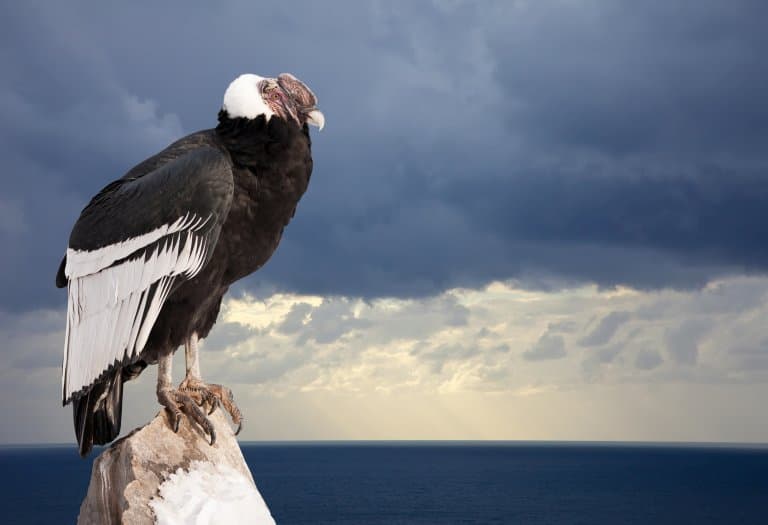
Andean Condor Facts Overview
| Habitat: | Mountainous habitats, including coastal mountains, and mountainous grasslands |
| Location: | Andean mountains |
| Lifespan: | Up to 70 years in the wild |
| Size: | Average 110cm in length, wingspan 3m |
| Weight: | Up to 15kg (33 lb) |
| Color: | Feathers mostly black with distinctive downy white collar around neck. Some white patches on wings and a bald, black or grey head |
| Diet: | Mainly scavenge carrion but also actively hunt small mammals and birds |
| Predators: | Chicks and eggs occasionally fall prey to carnivorous mammals |
| Top Speed: | 55 kph |
| No. of Species: |
1 |
| Conservation Status: |
Near Threatened |
Although they tend to roost at high altitudes in mountain crevices and ledges, they will also search for food along the coast, in open grassland, and will even scavenge in desert areas.
Like most vulture species, the Andean condor is primarily a scavenger. They search for recently deceased animals by sight, scanning the mountainous grassland for signs of carrion.
Andean condors spend much of their time soaring the skies in search of food. Although historically they would have fed mostly on dead wild animals such as the guanaco and deer, they are now most likely to feed on dead livestock, which have died as a result of disease or exposure.
They will often feed on still-born animals, giving the impression that the condor itself has killed the newborn livestock. Although solitary when searching for food, Andean condors often roost communally, sharing their cliff ledge or shelf with several other condors.
They tend to be placid and good natured with other condors and these communal roosts may help with maintaining heat throughout the night.
Unusual for a vulture species, Andean condors show sexual size dimorphism, with males considerably larger and heavier than females. Females also lack the comb and wattles that males possess and have a different eye colour than males do.
Andean condors are monogamous and generally mate for life, though males tend to be the more dominant of the two. Both sexes help incubate the eggs and feed the chicks. Males make surprisingly dedicated fathers and will sometimes feed the chicks more often than the females.
The IUCN has classified the Andean condor as vulnerable due to habitat loss and secondary poisoning from lead in hunter-killed corpses. Several countries have implemented captive breeding programmes.
Interesting Andean Condor Facts
1 They are one of the largest flying birds in the world
With a wingspan of 3m (9ft 8) and weighing up to 15kg, Andean condors are truly giants of the sky.
The average weight and wingspan of this condor beat pretty much every other flying animal, making it, generally, the largest flying creature in existence, on average.
The Andean condor is the largest flying bird in the Western hemisphere, and in the world when combining measurement of weight and wingspan together.1
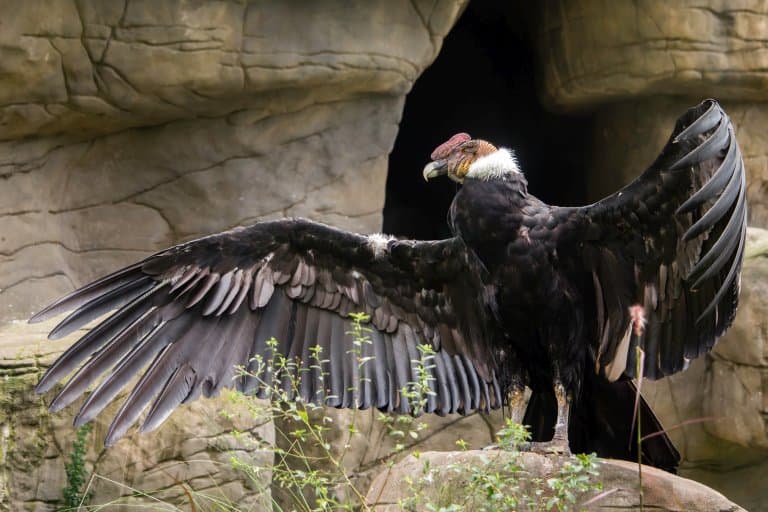
2. They have the largest wingspan of any raptor
At over 3m, the wingspan of an Andean condor is bigger than that of an ostrich. Male bustards do outclass them in weight, but not on wingspan.
Only species of albatross and pelican are larger than the Andean condor. 2
3. Their family means ‘he who cleans’
Their family name ‘Cathartidae’ includes other vultures in North and South America.
Cathartidae comes from the Greek word kathartes, meaning “he who cleans”, in reference to their contribution to eating dead animals and carrion. Their bald head is a useful adaptation when putting their heads inside carrion and stops blood from matting and clogging up any feathers. 3
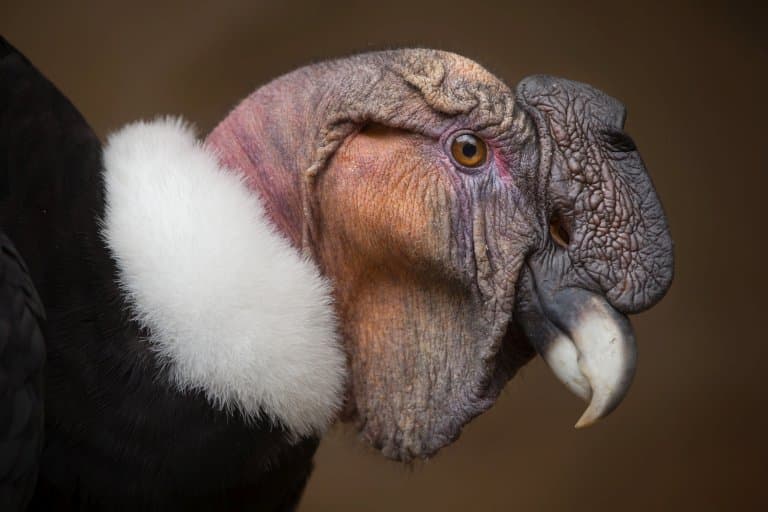
4. They are only 2 species of condor in the world
The other condor species, the California condor, is found in North America and is slightly smaller than its’ South American cousin.
Sadly the California condor became extinct in the wild in 1987, but have since been subject to intensive captive breeding programs and reintroduced to California and Arizona.
It’s estimated there is now over 500 individuals living in the wild today, making them incredibly rare.
5. Males have combs called carnucles
The fleshy lumps on a Male condors’ head, give females clues as to the health and fitness of that individual.
6. Unlike some other vulture species, Andean condors find food by sight
Many vultures use a well-developed sense of smell to find dead animals, however, Andean condors look for carrion by scanning the ground using their excellent eyesight.
Andean condors often rely on the activity of smaller vulture species, which find food through smell, to pinpoint dead animals on the ground. 4
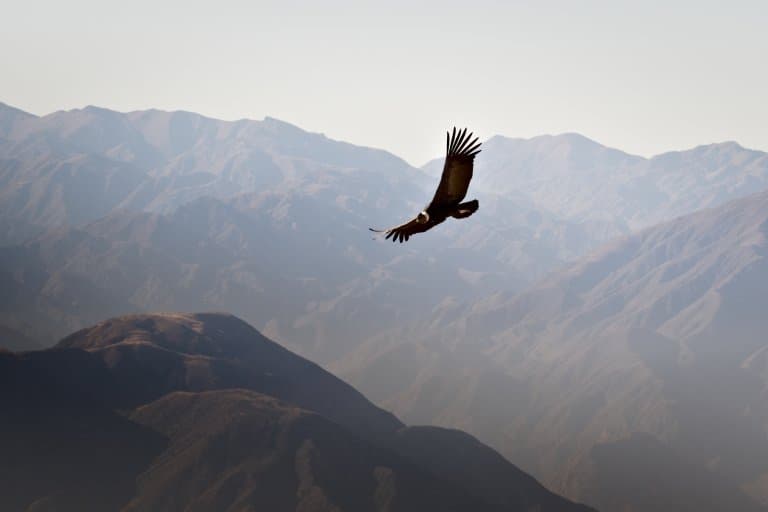
7. Andean condors are not just scavengers
Although they mostly feed on carrion, condors will also catch prey such as marmots and rabbits.
8. Males make very good fathers
Although females work as hard to raise their chicks, males unusually tend to feed the chicks more often and will even push females off eggs so as to incubate the eggs themselves.
Andean condors usually only produce 1 chick and juveniles will often remain with their parents for around 2 years before they become fully independent.
9. They can fly over 100km without flapping their wings
When soaring on the perfect thermal current, Andean condors use their huge wingspan to cover distances up to 160km without flapping their wings.
They will sometimes use these thermals to help them travel over 300km in one day when searching for carrion or prey.

10. Their feet are designed more for walking than gripping prey
As with other scavenging birds, condors do not have a powerful grip to catch large prey. Instead their feet are more flat and designed for walking and hopping around a carcass.
Instead use their great weight to pin prey down before tearing off meat using their sharp beaks. 5
11. They help other scavengers get more food
The guanaco, a relative of the llama, has incredibly tough skin that other vultures cannot break. The Andean condor’s beak is able to break this skin and this helps other scavengers in getting a meal. 6
12. They are one of the world’s longest-living birds
Many birds are known for their longevity, with some species regularly exceeding 30 or 40 years of age.
Condors, however, may be the longest-lived birds in the world. Andean condors have been reported of reaching over 70 years in age.
13. Andean condors are national and cultural symbols
These majestic birds are national symbols in several countries that include Bolivia, Chile, Columbia and Ecuador. The Andean condor is even found on some of those countries’ coat of arms as well as featuring on banknotes and stamps.
In many Andean cultures, the condor is still considered to this day a symbol of health and power and in ancient times, Native Americans revered the condor as a messenger of the gods and considered it a sacred animal. Many Inca artefacts depicting the Andean condor have been discovered, some dating back to the 14th century. 7
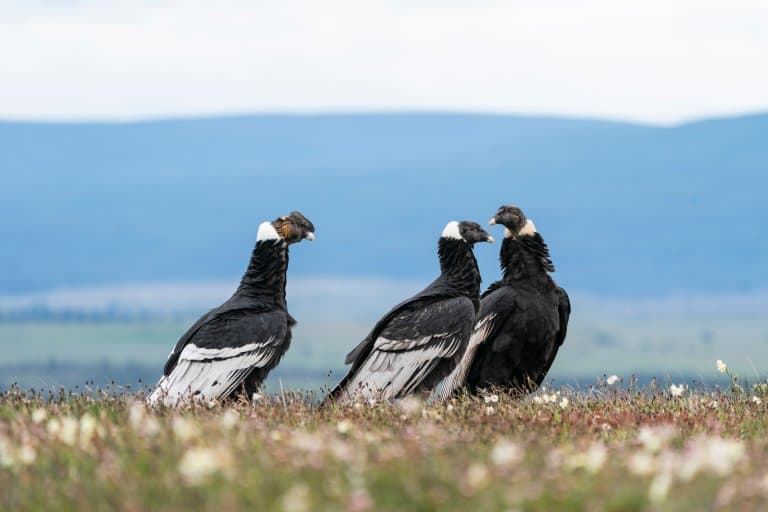
14. They are threatened by humans
Within their range, the number of Andean condors has been steadily decreasing due to persecution by man. Farmers in particular are likely to shoot or poison condors if they believe the birds are a threat to their livestock.
Although they are capable of killing newborn livestock such as cows or goats, Andean condors will rarely do so as they then have to contend with the adult parent chasing them off.
However due to some rare instances where condors have indeed killed young livestock, the Andean condor has gained a fiercely negative reputation amongst subsistence farmers and due to their remote location, they often are killed without any form of consequence dealt to persecutors.
15. Andean condors play an important part in the ecosystem
Though sometimes persecuted by humans, Andean condors play a vital role in the health of the Andes ecosystem. By feeding on carcasses of dead animals, they reduce the spread of disease within that area, which is especially important in such habitats where so many unique, indigenous animals exist.
Andean condors are also capable of tearing into much larger prey that other vultures, such as the turkey vulture. This allows other scavengers access to more edible parts of the carcass.
This is deemed a mutualistic relationship as the condors find food more easily by spotting the other vultures at a carcass and those smaller species are provided access to more meat in return.

Andean Condor Fact-File Summary
Scientific Classification
| Kingdom: | Animalia |
| Phylum: | Chordata |
| Class: | Aves |
| Order: | Falconiformes |
| Family: | Cathartidae |
| Genus: | Vultur |
| Species Name: |
Vultur Gryphus |
Fact Sources & References
- Pablo I. Plaza (2020), “Ecology and conservation of a rare species: What do we know and what may we do to preserve Andean condors?, Science Direct.
- “Vultur gryphus”, Animal Diversity Web.
- “Andean Condor Vultur gryphus”, Rainforest Alliance.
- “Andean Condor”, American Bird Conservacy.
- “Andean Condor”, National Geographic.
- John P. Rafferty (2023), “condor”, Britannica.
- “Andean Condor”, WCS Peru.
